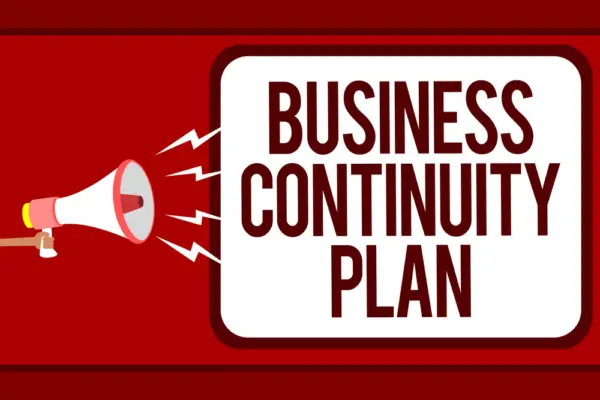A business continuity plan (BCP) is critical to an organization’s risk management strategy.
It is a blueprint for how a company will continue to operate in the event of a significant disruption, whether a natural disaster, cyber attack, or any other unforeseen event.
A well-designed BCP can help ensure that a company can maintain essential operations, minimize financial losses, and protect its reputation.
It is important to include several key elements to create an effective BCP. First and foremost, the plan should define the scope of the BCP, including the types of disruptions it is designed to address and the critical business functions that will be prioritized in the event of a disruption.
The plan should include a clear chain of command, specifying who will be responsible for which efforts.
Detailed procedures for business continuity during disruptions, including communication, data backup and recovery, and workforce continuity, are critical components of an effective BCP.

An effective BCP is a critical component of any organization’s risk management strategy.
Business continuity is the process of ensuring that organizations are prepared to respond to any disruption and minimize its impact on their operations.
Understanding Business Continuity
Definition and Importance
Business continuity refers to the process of creating a plan that helps an organization continue its operations in the event of a disruption or disaster.
The primary goal of business continuity is to ensure that essential business functions can continue with minimal disruption, regardless of the type or severity of the incident.
A business continuity plan (BCP) is a document that outlines the procedures and strategies that a company will follow to ensure that its operations can continue in the event of a disaster.
The BCP should identify potential risks, prioritize critical business functions, and outline the steps that need to be taken to ensure that these functions can continue.
The importance of business continuity planning cannot be overstated. Business Continuity Plan (BCP) is a comprehensive plan that outlines procedures and strategies to ensure that a company can continue to operate in case of a major disruption.
It is important for a company to have a BCP in place to comply with regulatory requirements and avoid legal or financial penalties.
The objectives and goals of a BCP should be aligned with the organization’s overall business strategy.
The primary objectives of a BCP are to ensure the safety of employees, minimize the impact of the disruption on operations, and enable the organization to resume normal business activities as quickly as possible.
Key Objectives and Goals
The primary objectives of a Business Continuity Plan (BCP) should be aligned with the organisation’s overall business strategy.
The BCP should aim to minimize the impact of potential disruptions and ensure the continuity of critical business operations.
- Identify potential risks and threats to the organization’s operations.
- Prioritize critical business functions and processes.
- Develop strategies and procedures to ensure these critical functions can continue during a disruption.
- Test and review the BCP regularly to ensure that it remains up-to-date and effective.
The goals of a BCP should be specific and measurable. For example, a goal might be to ensure that critical business functions can be restored within four hours of a disruption.
Another goal might be to ensure that all employees are trained in the procedures outlined in the BCP.
Business continuity planning (BCP) is a crucial process for organizations that want to minimize the impact of disruptions.
The goals of a BCP should be specific and measurable. For instance, an organization could set a goal to restore critical business functions within four hours of a disruption.
Another goal could be to ensure that all employees are trained in the procedures outlined in the BCP.
Risk Assessment and Analysis
Organizations can maintain customer confidence, comply with regulatory requirements, and avoid disruptions by identifying risks, prioritizing critical functions, and developing continuity strategies.
Conducting Business Impact Analysis
The organization should identify critical business functions and processes to conduct a business impact analysis.
To conduct a business impact analysis, the organization should identify critical business functions and processes and assess potential threats and their impact.
The organization should consider potential impacts, such as revenue loss, reputational damage, and regulatory non-compliance when identifying critical functions and potential disruptions to those functions.
Identifying Potential Threats
In addition to conducting a business impact analysis, organizations should identify potential threats that may disrupt their operations.
Having plans, implementing redundant systems, and investing in insurance coverage is also important.
Evaluating the likelihood and potential impact of threats such as natural disasters, cyber-attacks, supply chain disruptions, and human errors is essential.
Once the threats have been identified, they should be prioritized based on severity.
Risk Assessment” href=”https://riskpublishing.com/a-step-by-step-guide-to-risk-assessment/”Risk Assessment Example” href=”https://riskpublishing.com/risk-assessment-example/”Risk Assessment” href=”https://riskpublishing.com/a-step-by-step-guide-to-risk-assessment/”>>>Conducting a comprehensive risk assessment enables organizations
to identify potential threats and allocate resources effectively.Strategic Planning
A business continuity plan (BCP) is a strategic playbook created to help an organization maintain or quickly resume business functions in the face of disruption. Strategic planning is an essential component of a business continuity plan.
It involves developing and documenting a comprehensive approach to responding to and recovering from disruptions.
Developing the Continuity Plan
The first step in strategic planning for business continuity is developing the continuity plan.
The continuity plan should identify the critical business processes and systems that must be maintained or quickly restored during a disruption.
It should also outline the roles and responsibilities of the individuals involved in the recovery process.
To develop an effective continuity plan, it is important to involve key stakeholders from across the organization. This includes representatives from IT, operations, finance, and other relevant departments.
The continuity plan should be reviewed and updated regularly to remain relevant and effective.

Establishing Recovery Strategies
Once the continuity plan has been developed, the next step is establishing recovery strategies.
Recovery strategies are the specific actions that will be taken to restore critical business processes and systems in the event of a disruption.
Recovery strategies should be designed to minimize the impact of the disruption and enable the organization to resume operations as quickly as possible.
This may involve implementing redundancy measures, such as backup systems or alternate facilities.
It is important to test recovery strategies periodically to ensure they are effective and identify any areas needing improvement.
This may involve conducting simulations or tabletop exercises to simulate a disruption and test the effectiveness of the recovery strategies.
Developing a comprehensive approach to respond to and recover from disruptions is crucial for any organization. This involves creating a continuity plan and establishing recovery strategies.
By taking a proactive approach to business continuity planning, organizations can minimize the impact of disruptions and quickly resume operations.
Operational procedures are essential to any business continuity plan (BCP) and must be included.
Operational Procedures
A business continuity plan (BCP) must include operational procedures detailing how the organization will continue functioning during and after a disaster.
This section covers two important subsections: critical business functions and communication protocols.
Critical Business Functions
Critical business functions are the key processes that must continue to operate during a disaster to keep the organization running.
A BCP must identify and prioritise these functions based on their importance to the organization. These functions could include inventory management, customer service, payroll processing, and more.
Once the critical business functions are identified, the BCP should include procedures to ensure continuity during a disaster.
This could include backup systems, alternative locations, and employee training. It is important to test these procedures regularly to ensure they are effective and up-to-date.
Communication Protocols
Communication is crucial during a disaster, both within and with external stakeholders.
A BCP should include communication protocols that detail how the organization will communicate during a disaster.
This could include who is responsible for communicating with employees, customers, vendors, and other stakeholders and how they will be contacted.
The BCP should also include backup communication systems if the primary systems are unavailable.
This could include alternative phone lines, email addresses, and social media accounts. Testing these backup systems regularly is important to ensure they are effective.
A BCP must include operational procedures that ensure the organization can continue to function during and after a disaster.
This includes identifying critical business functions and communication protocols, implementing backup systems and regularly testing procedures.
Emergency Response and Management
In an emergency, a business continuity plan should include a detailed emergency response and management plan.
This plan should outline the steps that will be taken to respond to the emergency and manage the crisis.
Crisis Management Teams
One of the key components of an emergency response plan is the establishment of crisis management teams.
These teams should comprise individuals with the necessary skills and expertise to respond to emergencies.
The teams should assess the situation, make decisions, and communicate with employees and stakeholders.
The crisis management teams should include representatives from all relevant departments, such as IT, human resources, and finance.
The teams should also have a designated leader responsible for coordinating the response efforts and making decisions.
Emergency Response Procedures
Emergency response procedures should be developed to provide employees with clear instructions on what to do in an emergency.
These procedures should be communicated to all employees and regularly reviewed and updated.
The emergency response procedures should include instructions on how to evacuate the building, how to contact emergency services, and how to access critical systems and data.
The procedures should also include instructions on communicating with employees and stakeholders during the crisis.
An effective emergency response and management plan is essential for ensuring the safety of employees and minimizing the impact of an emergency on the business.
Businesses can better respond to emergencies and manage crises by implementing emergency response procedures, training, and testing for their continuity plan.
Training and Testing
Business continuity planning is not a one-time exercise. It is an ongoing process, and employee training programs, regular testing, and drills are essential to a successful business continuity plan.
Employee Training Programs
Employee training programs should be designed to ensure that all employees are aware of their roles and responsibilities during an emergency.
The training should cover the procedures to be followed, the communication channels used, and the resources available to employees.
Training documentation should include dates, type of event(s), and name(s) of participants.
Documentation also includes test results, feedback forms, participant questionnaires, and other documents resulting from the event.

Regular Testing and Drills
Regular testing and drills are essential to ensure the business continuity plan is effective and current.
Testing and drills should be conducted annually and more frequently for critical functions.
The business continuity and disaster recovery test types appropriate for an organization will depend on various factors, including its size and nature, available resources, and the BCDR testing stage.
These involve real-time discussions with organizational leaders and anyone with a critical role in the BCDR plan.
The plan should be reviewed and updated during testing and drills as necessary. The results of the testing and drills should be documented, and any deficiencies or areas for improvement should be identified and addressed.
Employee training programs, regular testing, and drills are critical to a viable business continuity program.
These activities ensure that employees know their roles and responsibilities during an emergency and that the business continuity plan is effective and up-to-date.
Review and Maintenance
A business continuity plan (BCP) is not a one-time project. To ensure its effectiveness, it must be reviewed and maintained regularly.
This section covers the schedule for regular updates and the continuous improvement process.
Schedule for Regular Updates
A BCP must be reviewed and updated regularly to remain relevant and effective.
The frequency of updates depends on the nature of the business, the risks it faces, and the rate of change in the business environment. Typically, a BCP should be reviewed and updated at least annually.
The review process should involve all stakeholders, including senior management, business unit leaders, and IT personnel.
The review should assess the plan’s effectiveness in addressing the risks identified, the adequacy of the resources allocated, and the suitability of the recovery strategies proposed.
The review should also identify any changes in the business environment that may require updates to the plan.
Continuous Improvement Process
A BCP is not a static document. It should be continuously improved to reflect changes in the business environment, emerging risks, and new recovery technologies.
The continuous improvement process should be an integral part of the BCP, with clear roles and responsibilities to ensure its effectiveness.
The continuous improvement should involve regularly monitoring the BCP’s performance, including testing and exercising.
The testing should be based on realistic scenarios that simulate the risks identified in the BCP. The testing results should be used to identify areas for improvement, which should be addressed promptly.
A BCP is a critical tool for ensuring business resilience. However, its effectiveness depends on its review and maintenance.
A BCP must be reviewed and updated regularly, and a continuous improvement process must be in place to ensure its effectiveness.
Recovery and Restoration
A key component of any business continuity plan is the recovery and restoration process.
This process involves restoring the organization’s critical business functions and IT systems after a disruptive event.
Recovery Time and Point Objectives
To ensure that the recovery and restoration process is effective, it is important to establish recovery time objectives (RTOs) and recovery point objectives (RPOs).
RTO refers to the maximum amount of time an organization can afford without a critical business function or IT system. RPO refers to the maximum amount of data loss an organization can tolerate.
Establishing RTOs and RPOs requires thoroughly analysing the organization’s critical business functions and IT systems.
The analysis should identify the dependencies between different systems and functions and the potential impact of a disruption.
Restoration of Operations
Once the RTOs and RPOs have been established, operations can be restored. This process involves restoring the organization’s critical business functions and IT systems to their pre-disruption state.
The restoration process should be well-documented and tested regularly to ensure effectiveness.
Having a clear communication plan to keep stakeholders informed throughout the restoration process.
The recovery and restoration process is critical to any business continuity plan.

By establishing RTOs and RPOs and implementing an effective restoration process, organizations can minimize the impact of disruptive events and ensure they can continue operating in the face of adversity.
Frequently Asked Questions
What are the essential components of a comprehensive business continuity plan?
A comprehensive business continuity plan should include the following essential components:
- Business Impact Analysis (BIA).
- Risk Assessment.
- Recovery Strategies.
- Plan Development.
- Testing and Maintenance.
How does a disaster recovery plan differ from a business continuity plan?
A disaster recovery plan (DRP) focuses on restoring IT infrastructure and data after a disruptive event, while a business continuity plan (BCP) is a broader plan that covers all aspects of business operations, including people, processes, and technology.
Can you outline the five key steps in developing a business continuity plan?
The five key steps involved in developing a business continuity plan are:
- Conduct a Business Impact Analysis (BIA).
- Identify Risks and Threats.
- Develop Recovery Strategies.
- Create the Business Continuity Plan.
- Test and Maintain the Plan.
What are the critical functions that a business continuity plan should address?
A business continuity plan should address the critical functions necessary to keep the business running during and after a disruption. These functions may include:
- Communication and Notification.
- Employee Safety and Security.
- IT Infrastructure and Data Recovery.
- Supply Chain and Logistics.
- Financial Management.
How can a business continuity plan be tested and maintained for effectiveness?
A business continuity plan can be tested and maintained for effectiveness through the following ways:
- Regular Plan Review and Update.
- Training and Awareness Programs.
- Tabletop Exercises.
- Simulation Drills.
- Full-Scale Testing.
What should be included in a business continuity policy to ensure organizational resilience?
A business continuity policy should include the following elements to ensure organizational resilience:
- Policy Statement and Objectives.
- Roles and Responsibilities.
- Scope and Applicability.
- Business Impact Analysis (BIA).
- Risk Assessment.
- Recovery Strategies.
- Plan Development.
- Testing and Maintenance.
- Incident Management.
- Training and Awareness Programs.
Download
Contact chrisekai@gmail.com or view our service page for more comprehensive business continuity plans.

Chris Ekai is a Risk Management expert with over 10 years of experience in the field. He has a Master’s(MSc) degree in Risk Management from University of Portsmouth and is a CPA and Finance professional. He currently works as a Content Manager at Risk Publishing, writing about Enterprise Risk Management, Business Continuity Management and Project Management.

